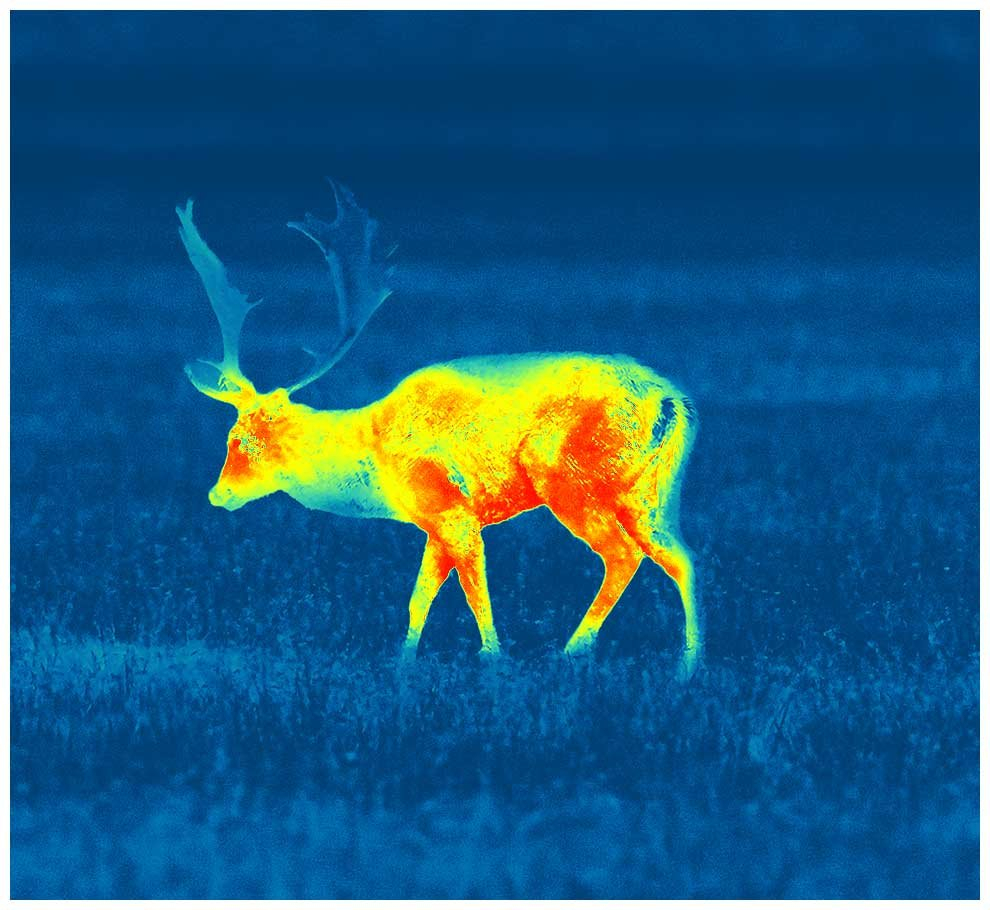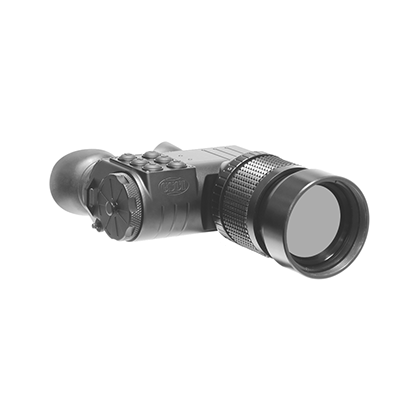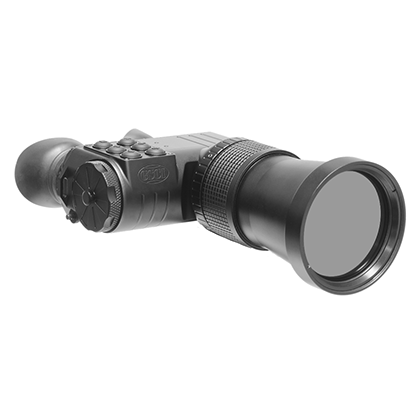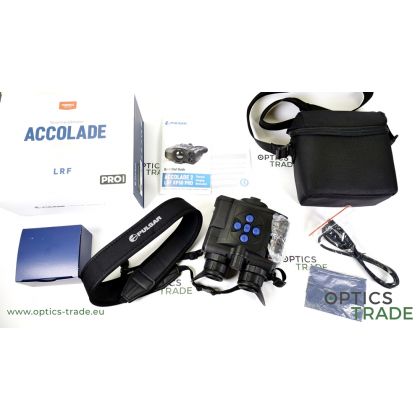Mounts
Thermal Imaging Binoculars
Sub Categories
The introduction of thermal imaging devices into the civilian market was a defining moment for the optics industry. For the first time ever, hunters and wildlife observers were no longer limited in their pursuits by ambient light and the sparseness of environmental obstacles.
These devices are especially rugged, made for rough handling in the wide-open and under extreme weather conditions. The external surfaces of the housing are coated with thick rubber. Thanks to internal purging with dry nitrogen or argon gas, thermal binos are remarkably impervious to internal fogging of the lens and water damage.
In all other physical aspects, these thermal imagers intentionally resemble and imitate the use of classic daytime binoculars. Since people were created to use both eyes, binoculars are the preferred option to scopes. They allow for a faster transition from observing to shooting since both pupils dilate and contract the same.
Compared to night vision devices, thermal imagers offer extraordinarily long detection ranges. Their capabilities are magnified by the incorporation of built-in laser rangefinders. The downside of thermal imaging binoculars is the added weight and bulkier form.
The sensor (heat detector) is the heart of any thermal imaging optics. In many ways, everything you need to know about the quality of a thermal binocular is summarized under sensor specifications. The standard sensor resolution is 640x480 pixels, while the size of a singular pixel is about 17 or 12 microns.
Thermal imaging enables you to see beyond the limitations of conventional optics. They are especially suitable for hunters, wildlife enthusiasts, security sector, first responders on search or rescue missions and military use. Note that thermal optics show only warm parts of animals so they are not the best choice for trophy hunters.
Hunting
The incorporation of any thermal imaging optics with traditional hunting is a complete gamechanger. For the first time ever, the hunter is able to see the exact number of animals in the hunting-ground, follow their movement and behavioral patterns. Thermal imaging devices allow for uninterrupted game observation in the forest and overgrown terrains where conventional optics fail, as there are too many physical obstacles getting in the way of a clear view. But that is no longer an issue with thermal imaging.
Thermal imaging optical devices can also be used during the day. This is especially useful when surveying extensive surroundings with the intent of searching for wild game in the area. For example, it’s much easier to spot a lone fox in a large field when scanning the surface with a thermal imaging device than when relying on plain sight.
The obvious downside of thermal imaging is that it shows only the warm parts of the animal, while others (e.g. trophy and hooves) are much harder to scan since they do not emanate body heat. But not for long. As the sensor technology advances, thermal imaging optics are becoming more and more reliable when accessing the trophy of the game.
Many hunters find that thermal imaging devices are particularly important in those frantic moments after the shot is released. They are able to track the flight response of the game and film the rapid movement. If the shot failed to land an instant kill, thermal imaging makes finding the fatally wounded but still running game much easier. Since conventional daytime binoculars have been in use for decades, modern hunters continue to place binoculars above monoculars in thermal imaging as well.
Sensors
Although all thermal imaging optics are still a relatively new addition to the civilian market, they have already undergone many upgrades. This fast development is the most apparent in sensor (heat detector) capabilities. The biggest competitors in this market niche launch new thermal imaging sensors in two-year cycles or even faster than that.
Before we go further into detail, it’s important to first enumerate the main factors that define the quality of the thermal sensor and with that, the quality of the image displayed through the optic.
Main factors of sensor quality are:
-
sensor resolution
-
pixel size
-
NETD (Noise Equivalent Temperature Difference)
-
calibration modes
-
lens diameter
Sensor Resolution
Let’s start with sensor resolution. The last 5 years where a revolution when it comes to the improved resolution of thermal imaging devices.
The most common resolution of sensors on the civilian market today is 388x284 pixels. More advanced models already offer 640x320 graphics. Devices with bigger thermal sensor resolutions are a rarity. In fact, the few thermal imaging devices with the most impressive display resolution of 1260x800 pixels are also the most expensive options for civilian use out there.
Pixel Size
The pixel size is also shrinking. Only a decade ago, the most common size was 25 microns but the old standard has been practically halved since then, with 12 to 17μm being the current industry norm. Pulsar Accolade thermal imaging binocular use 17-micron pixel pitch but there have already been plenty of more recent launches of devices with 12-micron pixels. Smaller are the pixels, the better and more detailed is the image.
But that’s not the only improvement that comes with the sizing-down. Though indirectly, the size of the pixels also factors into the size of the sensor and with that, the overall size of the final unit. Just take a look at practical, pocket-sized thermal scopes like Pulsar Axion and Flir Breach. This is another feature that will only get better in the future.
Noise Equivalent Temperature Difference
NETD factor is not nearly mentioned enough when discussing the differences between current thermal imaging choices on the civilian market. The acronym stands for Noise Equivalent Temperature Difference and it tells the user what can be the smallest temperature difference between two objects for the thermal sensor to detect the distinction. This factor has a direct effect on the number of details preserved in the displayed image.
When it comes to the initial launches of thermal binoculars, most sensors had the NETD factor of above 60mK. The best options on the market right offer NETD factors of approximately 40mK. Note that the difference in image quality between sensors with 60mK NETD and 40mK factors is staggering, even if both devices feature the exact same size and number of pixels! Some sensors of the newest thermal imaging optics have a NETD factor of below 35mk.
Calibration Modes
In nature, targets appear at different ranges and the environment has different temperatures. Over time and with use, the quality of the images shown on the display degrades. The sensor has to be calibrated every few minutes or seconds. When this happens, the frame sequence on the display freezes for a fraction of a second. The result of calibration is improved and more detailed image quality.
There are three calibration modes:
-
manual
-
automatic
-
semi-automatic
When on automatic mode, the software algorithm checks the image for drops in quality. This happens at regular intervals and is the preferred option for most users.
In most devices, the shutter closes for the time of the calibration. There is a distinct sound associated with shutters closing and opening.
Some thermal imaging devices have a feature called silent or shutterless calibration, where the shutters don’t close when recalibrating. Shutterless devices are available in manual and automatic mode. With a manual calibration mode, the user presses a button when the quality of the image fades. This is a more premium solution that comes with a higher price tag.
Lens Diameter
All that state-of-the-art technology aside, much of sensor performance still comes down to the simple question: What is the lens diameter?. Bigger the physical lens, the more preserved and visible are the details in the final image.
In combination with the size of the sensor, the lens diameter also determines the field of view. Bigger the lens, the narrower is the FOV. For example, Helion XP38 and XP50 are built around the same sensor but the considerably larger diameter of the latter results in 45 fewer meters of FOV. The other way around is also true; two thermal imaging devices of the same lens diameter but different sensor sizes will provide entirely different fields of view.
The most commonly used lens material in thermal imaging is germanium glass. Though structurally similar to silicon or aluminum, germanium glass is an incredibly resistant material that offers good infrared transparency and low optical dispersion. Topped off with multi-coat varnish, the near diamond-hard surface of germanium lens can withstand heavy handling in the harshest environments.
Display Refresh Rate
Display Refresh Rate represents the number of image frames that appear on the display in each second. It is measured in Hertz. The higher the refresh rate, the smoother the rendering and less blurry will the image appear. Note that if the display refresh rate is 30Hz or above, the human brain perceives it as movement and no longer a sequence of static frames.
The oldest devices sold on the civilian market had a refresh rate of 9Hz. Many are still available for purchase at a much lower cost than newer, technologically improved models. But devices with a 9Hz refresh rate are not recommended for observation of moving objects at a long distance. It’s hard enough to track fleeing animals without outdated software getting in the way.

Thermal Imaging Optics - HIGH Image Frequency vs LOW Image Frequency
In fact, everything below 30Hz looks unnatural and the gaps are clearly noticeable. Premium 50Hz devices are preferred because they provide a real-time image with no delay. Their continuous smooth operation is well worth the extra cost.
Laser Rangefinder
Another innovation is the incorporation of laser rangefinders into thermal imaging devices. The reason for it is that accessing the distance can be very hard when using a thermal imaging device.
Users will find that the image and depth impression are entirely different when observing the same object with plain sight than when looking through thermal imaging binoculars. When using the latter, the hunter will get the impression that animals are further away than where they are in reality.
The margin of error when making these distance approximations is especially a problem when you consider that thermal imaging devices can detect warm objects that are 2 kilometers away. It’s only reasonable that a hunter cannot rely on their sense of depth alone to make a perfect shot. Indeed, thermal optics with integrated laser rangefinders are more than welcome addition.

Thermal Imaging Optics - Alternative Distance Measurement
Most devices already offer an alternative method of accessing distances. That is, the user can have their pick between 3 different animal observing modes (e.g. hare, boar and red deer). There are two lines for their height.
When the user is observing the animal with the help of a menu, one line is placed horizontally to the ground, while the other marks the highest point of the animal. The device then approximates the actual distance but that’s a highly unreliable method since individual specimens of the same animal come in different sizes and it’s difficult to set those lines properly anyways.
Thermal Imaging vs Night Vision
Thermal imaging devices are based on heat detectors in contrast with NV devices that rely on IR illuminators. However, there's been quite some talk about fusion devices that combine both concepts in a single device. Perhaps this too is something to look out for in the future.
Thermal binoculars offers really long detection ranges. If you compare them to conventional night vision optics, where seeing anything beyond 300 meters is made difficult, thermal imaging devices are definitely the way to go. With the latter, the user can spot a warm object or an animal 2 kilometers away.

Thermal Imaging Optics - Seeing Beyond Environmental Obstacles
In addition to that, hunters and wildlife observators are able to detect animals in a forest or when concealed by thick shrubs. Physical obstacles are not a problem for heat-detecting sensors that power thermal imagers. Compare that to night vision optics, which rely on IR illuminators. The infrared beam of light reflects from all surfaces in its path, making it impossible to detect anything beyond the greenery that marks the forest line. IR illuminators also fail with other environmental obstacles like a thick fog, smoke, and rain. Light beams simply ricochet off tiny droplets in the air. What is more, the light emitted by IR illuminators is on a wavelength perceptible to animals. Since no laser is required for thermal imaging devices, they have a clear edge over NV optics in this aspect as well.
But it is also important to point out that with the advantage of range, a little bit of recognition is lost. In other words, whereas conventional NV optics show the entire object indiscriminately, thermal imaging devices can only detect heat (as in, only the warm parts of an animal, for example). That means that accessing the trophy of the game is made almost impossible with thermal imaging devices since animal parts like antlers and horns are not warm and, consequently, will not show up on the display. It’s definitely something to consider when looking for the right optics for your field of application.

Thermal Imaging Optics - Not Suitable for Trophy Hunting
Thermal binoculars are especially useful in non-trophy hunting, surveillance work, military and security sectors in general and on rescue missions. Of course, the majority of users are hunters who need binoculars that they can rely on in low light situations. But once again, note that thermal binoculars on their own are not optimal for trophy hunters. We suggest that they consider analog NV devices with the addition of a thermal imaging clip-on and get the best of both worlds.
Camera
Like most thermal imaging optics, binoculars also let the user take photos or even film clips of the action. Modern hunters and wildlife enthusiasts, in particular, are on the lookout for devices with audio-video support that make a one-man journey into the great wide open a shared experience. Not only that, but newer thermal imagers also come with internal storage or even allow for the insertion of an SD card or offer a different means of saving photo and video material.
The clear downside of thermal imaging optics is image resolution. It still lags behind analog NV devices. The most standard display refresh rate in thermal imagers is 30Hz, whereas analog night vision devices have this frequency set at 50Hz. Such an impressive frame rate is matched only by premium thermal imaging devices.
Another flaw of thermal imaging binocular is the considerable energy drain. They burn through power units much faster than their night vision counterparts. Even specialized batteries can only last for a couple of hours. That means hunts and other prolonged excursions into the wild can’t go without back-up batteries.
However, it’s also true that analog NV devices need extra caution. If the user exposes them to a bright source of light, it will damage the photocathode. But there is no need for these concerns with thermal imaging devices. Thermal imaging optical devices work just as well during the day as they do during the night. This dual use gives them added versatility over analog NV optics.
Thermal Binocular vs Thermal Monocular
Thermal binoculars are ordinary thermal imaging devices, just like monoculars or scopes and clip-on systems. The only change is in the physical form as they allow the person to use both eyes. That means that thermal imaging binocular use two displays or only one display in combination with a system of prisms. But there is no actual difference in resolution or technologies employed.
People were meant to use both eyes for seeing. Thermal imaging binocular, therefore, enable the most natural viewing experience. But does that also mean the binocular form is the absolute best choice for everyone?
There are many conflicting opinions as to which device form is the best. One thing that works in binoculars’ favor is that all thermal imaging devices use bright displays. Users of devices that only require one eye for observations face an obvious problem. Only one of their pupils dilates when looking at a bright display, while the other remains contracted due to the low light natural environment and for the user, this artificial contrast can be slightly uncomfortable or even disorienting. Binoculars solve that issue since the user employs both eyes and with that, there’s is no difference in pupil diameters.
Still, some hunters claim that monoculars enable a faster transition from observing to shooting. That’s because they use one eye for thermal monocular and another to look into the riflescope. In that case, they don’t have to wait a moment before both of their eyes accommodate to ambient light. This is not true for everyone. There are people with a strong left or right eye preference, choosing to use the same side for looking both through the imager and through the scope. In that case, the contrast between bright display to dark riflescope view-through is quite startling.
In the end, the choice between thermal binoculars and monoculars simply comes down to the user’s personal preference.

Thermal Imaging Optics - Physical Properties
What’s also interesting is that some thermal binoculars intentionally mimic the use and handling of classic mechanical binoculars. They utilize a focusing wheel in the center and diopter compensation rings around both eyepieces that are no different than the ones on daytime binoculars. Some even allow the user to adjust the interpupillary distance. But they are much more heavy-duty, created to withstand inclement elements. The disadvantage of binoculars is in the added weight and bulkier form. Monoculars are much handier and easier to carry around.
There is also an obvious difference when comparing the prices. Thermal binoculars are also more expensive than other devices of this type. They tend to cost about 600 or 1000 euros more than a monocular device of comparable capabilities. The reason behind the price increase is the addition of another display, a second eyepiece and there’s also bigger magnesium housing. Obviously, all that added comfort costs extra.
Power Sources
Thermal imaging optics are known for fast energy drain and manufacturers are making strides to improve on this front. With the rapid expansion of this market niche of optics, there are many options available. Still, the majority of thermal imaging manufacturers decide on one of the 3 most popular energy sources.
3 most popular power sources:
-
integrated batteries
-
rechargeable
-
generic removable batteries
-
rechargeable
-
non-rechargeable
-
specialized removable batteries
-
rechargeable
Built-In (Rechargeable) Batteries
This is the most commonly used energy source solution in the civilian market.
For one, integrated batteries are the most cost-effective batteries to make. Manufacturers often select built-in batteries because they give them more freedom in designing waterproof housing and achieving the desired overall look of the finished product.
Indeed, thermal imagers and night vision optics are known to be bulky and function-over-form devices, not at all smooth-polished gadgets with the streamlined design of classic binoculars and riflescopes. There is a major room for improvement there and batteries of smaller dimensions are a step in the right direction.
Integrated batteries are rechargeable, suitable for frequent use. Once these batteries exhaust their lifespan, the user has to arrange a service replacement or the entire unit is of no use.
Removable (Rechargeable or Non-Rechargeable) Batteries - Generic
The biggest advantage of using a device with an external battery solution is it can be easily replaced in the field, mid-action. This is especially important with thermal imaging devices, known for the fast energy drain. This way, thermal imagers can be used longer and without the bothersome overnight charging required to power built-in batteries.
The beauty of using standard-type batteries like AA+ and CR2032 is that you can get them anywhere. Generic batteries are readily available to hunters on-the-go, in non-specialized stores. There is also the choice between rechargeable and non-rechargeable units.
Among the reasons to reconsider this power source is that standard-type, generic batteries drain much faster than purpose-built ones. Both integrated and external batteries that were manufactured with the high-power needs of thermal imagers in mind, will last you much longer. There is also a concern of the environmental impact. Generic, easily-disposable batteries are a burden on the environment. They might be small and practical but they are also hazardous and hard to recycle.
Removable (Rechargeable) Batteries - Specialized
These batteries can be replaced but are much more capable than their generic counterparts. They are also always rechargeable, granting the user years of convenient re-use. Note that the lifespan of the thermal binoculars does not depend on the purpose-built batteries. All units can be replaced or serviced separately. So with a back-up battery of this kind, the user can continue to use their binos with no interruptions.
For now, Pulsar remains the only manufacturer of thermal imaging devices that makes device-specific batteries. If we take a look at their select repertoire, IPS batteries are compatible with all their Helion, Trail and Accolade 1 & Accolade 2 model series. The APS ones work on Axion, Digex and Thermion devices. There’s also the EP3i battery pack and other options to explore. The added bonus of these batteries is that the prices are very affordable and the Pulsar service arranges quick in-warranty replacements.
A short presentation of Thermal Binoculars is available here.
Video presentation
Filters
Sort
Filters
Sort



















